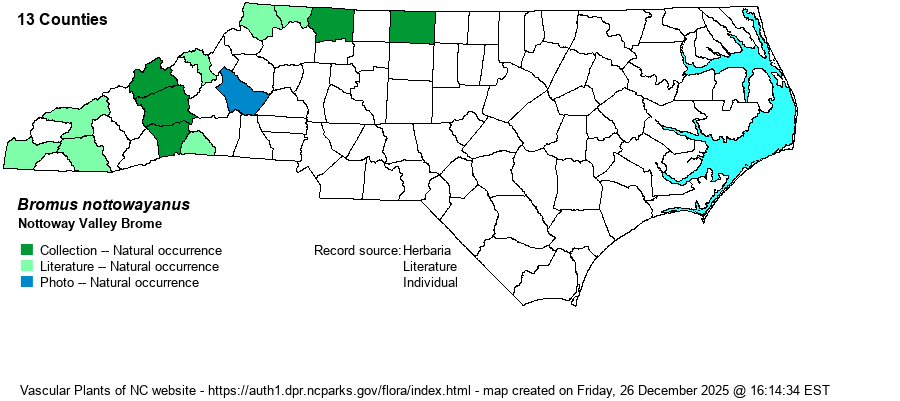| Author | Fernald | |
| Distribution | Mountains (with gaps) and upper Piedmont. In this case, the wide gaps in the Mountains are probably not biologically real, as the habitats are not specialized, and the species is difficult to identify.
NY to MO, south to NC, northern AL, and OK. Distribution not well known, due to confusion with B. pubescens. | |
| Abundance | Rare to uncommon throughout, though presumably overlooked or misidentified as B. pubescens and/or B. latiglumis. This is a Watch List species, and the species seems to merit a State Rank of S2, instead of the very rare S1?. | |
| Habitat | From specimen labels: "mixed deciduous forest", "rocky wooded slope", "roadside near Dan River", "rich woods above Elk Creek". "Moist forests, especially along small stream bottoms" (Weakley 2018). | |
| Phenology | Flowering and fruiting June-August. | |
| Identification | Our native brome grasses typically grow 3-4 feet tall and have inflorescences with arching branches and drooping spikes. Nottoway Valley Brome has 5-veined upper glumes (vs. 3-veined glumes in B. pubescens and B. ciliatus); and 2-9 stem nodes (vs. 9-20 nodes in B. latiglumis). | |
| Taxonomic Comments | For decades this grass went unrecognized and treated as part of B. pubescens. Farther back, the species -- and several others included on this website -- was included within B. purgans in RAB (1968).
Bromus is an important genus of grasses for their value as forage (many species) or for the harm they cause to the guts of grazing animals (a few species). In most of our species, inflorescences arch over and cause the spikelets to droop; thus the plants are often graceful looking. Bromus, Festuca, and Poa all can look quite similar to beginners (and even veterans!), because they all have multi-flowered spikelets. Generally speaking, Bromus taxa have much the largest spikelets, and most Poa taxa have a tuft of wispy hairs at the base of each floret (lacking in the other genera). Bromus and Festuca taxa have obvious awns on the florets that are absent in Poa taxa. With field experience and careful use of keys, one can eventually handle these genera. | |
| Other Common Name(s) | Satin Brome, Virginia Brome, Nottoway River Brome, Nottoway Brome | |
| State Rank | S1? [S2] | |
| Global Rank | G4G5 | |
| State Status | W7 | |
| US Status | | |
| USACE-agcp | | |
| USACE-emp | | |

